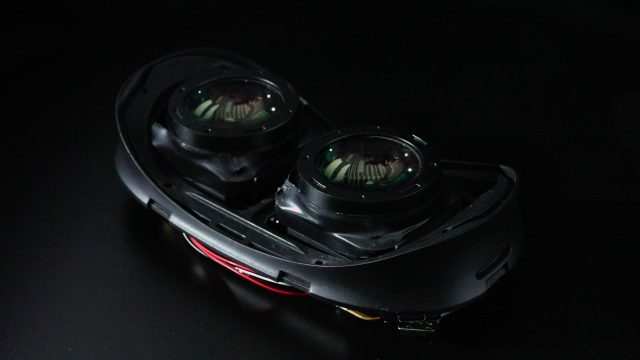When Pimax recently unveiled its eagerly anticipated Dream Air VR headset, the virtual reality community was abuzz with curiosity. Fans had a myriad of questions, and we took it upon ourselves to seek answers directly from the company. Alongside those insights, we also managed to catch a sneak peek at early prototypes, compile a detailed spec sheet, and get updates on some of Pimax’s pending product releases.
As a veteran player in the VR world, Pimax has gained a reputation over time for producing robust headsets. However, the company frequently faces backlash due to the perceived lack of polish in their products, scattered strategic decisions, and a tendency to make new announcements before fulfilling older obligations.
The unveiling of the compact Dream Air headset naturally reignited some of these criticisms. Many in the community wondered how Pimax plans to address these persistent issues this time. Armed with these questions, we reached out to Pimax, and here’s the scoop we got: complete with prototype images, a thorough specs list, and updates on previously announced but as-yet unreleased products.
Q: How confident is Pimax in delivering the Dream Air headset by May 2025 in substantial quantities?
A: We’ve been at work on both the Crystal Super micro-OLED and the Dream Air for over a year. Internally, they’re quite similar. With a fully operational optical engine already in our grasp, we’re optimistic the remaining development time until May will suffice—the same timeframe it took for the Crystal Super last year. The Dream Air will share its optical engine solution with the Crystal Super, leveraging the core technology but in a fresh design. You can delve deeper into the shared technical components of the Dream Air and Crystal Super micro-OLED here. Our main hiccup might be sourcing micro-OLED panels and maybe some challenges with the ringless controllers. We expect to initially ship some units with ringed controllers, like the ones from the Crystal/Light/Super series, but aim to switch to ringless versions later. We’re quite confident about shipping around 200 to 300 headsets by May. This urgency was also a key reason behind announcing the headset now.
Q: Why the early announcement of another headset so soon after the Super? And what prompted opening pre-orders already?
A: There are a few reasons. We wanted to introduce the Dream Air ahead of the Super’s shipping schedule so that our community wouldn’t face buyer’s remorse, wishing they had opted for the newer model. We’ve already observed discussions around this on our Discord. Users can actually swap their pre-orders from the Super to the Dream Air if they wish. Furthermore, the demand for micro-OLED panels outstrips supply in the market, which means longer lead times. By taking pre-orders now, we gauge demand more accurately and ensure we order enough panels for the Dream Air’s May shipment. Given our tight deadline, these orders need to happen by early January—factoring in suppliers’ downtime during Chinese New Year. It’s not just us; other products face similar shortages right now, which is why they usually don’t allow refundable pre-orders. However, our pre-orders can be refunded prior to shipping, and we also offer a $1 reservation option.
Q: What do you say to critics suggesting Pimax should concentrate on fewer products?
A: We aspire to be a company offering multiple SKUs since VR headsets are rapidly diversifying. Our core goal remains delivering top-notch experiences, with the Crystal line and the new Dream line catering to distinct user needs. That being said, all our headsets share significant technological commonalities—from software to hardware—all firmly centered on PCVR, a lesson we learned from the past (recall the Portal, which wasn’t focused on PCVR). Boasting a nine-year track record in crafting VR headsets, we own two R&D centers and are establishing our second assembly line to support this multi-SKU strategy. By sharing technology across products, we can channel more resources into innovations benefiting all headsets. This strategy prevents a concentrated peak in sales, allowing us to manage production resources more efficiently throughout the year since we operate our own factory with dedicated staff. Peaks, as we’ve seen, can strain operations.
Q: Are more headsets coming from Pimax?
A: We’ll be refreshing some older models, but apart from the Dream Air and Crystal Super, no headsets boasting more advanced specs are scheduled, except for the 12K.
Q: How far along is the Dream Air’s design? Were the announced renders just concept images? Is there a working prototype?
A: The headset’s internals are fully designed, with a functional optical engine ready for testing. Software-wise, it’s consistent with Crystal Super—featuring SLAM tracking, eye-tracking, hand-tracking, and all settings available in the Pimax Play. Externally, we are currently utilizing the Crystal Super casing (micro-OLED optical engine) while refining the Dream Air’s outer shell. Here are images of two prototypes crafted during the development phase.
Newer Prototype:
Older Prototype:

(Note: This update corrected an earlier error in labeling the prototypes.)
Q: Will Cobb, the standalone module for Dream Air, arrive in 2025?
A: We don’t have a precise ETA for Cobb currently. As an add-on for Dream Air, we’re still integrating additional features that weren’t highlighted in our Frontier announcement.
Q: What safety measures are equipped to ensure the auto-tightening headstrap isn’t a hazard if it malfunctions?
A: Our main consideration is ensuring it’s robust enough to support the light headset, yet not too tight to cause harm. The internal straps utilize elastic rubber, leveraging technology similar to that in self-tightening shoes like Nike’s Auto Adapt.
Q: Are the head straps replaceable? How can this be done?
A: Yes, the head strap is designed to be detachable at the stems.
Q: Is there potential for this to eventually run HorizonOS or AndroidXR?
A: Currently, there are no plans for such integration. The headset mirrors the Crystal Super’s micro-OLED optical engine, aligning with Pimax Play as a PC VR headset and is compatible with OpenXR/OpenVR runtime as well as SteamVR.
Pimax was also kind enough to provide an in-depth rundown of the Dream Air headset’s specifications:
Pimax Dream Air Specifications
Visuals:
- Display: 2 × micro-OLED with 100% DCI-P3 colors
- Resolution per-eye: 13MP (3,840 × 3,552)
- Max refresh rate: 90Hz
- Optics: Pancake
- Field-of-view: 102°H
- Pass-through view: Black & white
- Optical adjustments: Continuous IPD (automatic), Prescription lenses (optional)
- IPD adjustment range: 58–72mm
Input & Output:
- Connectors: DP 1.4 (PC) to USB-C (headset), 1 × USB-C accessory port
- Input: Dream Air controllers (rechargeable battery), Hand-tracking
- Audio: In-headstrap speakers
- Microphone: Dual-microphone
- Weight: 200g
Sensing:
- Headset-tracking: Inside-out (no external beacons), optional SteamVR Tracking
- Controller-tracking: Headset-tracked (requires line-of-sight)
- Eye-tracking: Yes
- On-board cameras: 4 × tracking, 2 × passthrough
Price:
- MSRP: $1,900
Pimax Shipping Update
Q: Could you share the latest shipping schedule for Pimax’s unreleased products?
A: Crystal Super is prepped for a demo at CES 2025, especially the QLED 57 PPD optical engine, which ships by January’s end. The 50 PPD and micro-OLED optical engines are almost ready, targeting March and April launches. The Crystal Light, lacking the local dimming feature, is set for June 2025, with a more affordable price tag. Additionally, the 60G Airlink for the original Crystal will debut at CES2025, with an external beta test imminent, launching in April 2025. As for the 12K, we can’t provide a definite ETA. Initial technical solutions didn’t meet our standards, such as the dual DP 1.4 approach and an undisclosed panel solution.
Got more questions for Pimax? Feel free to leave them in the comments!













































